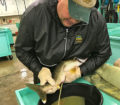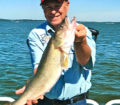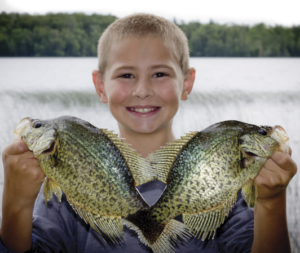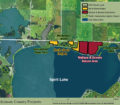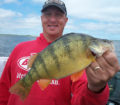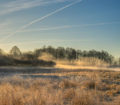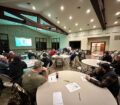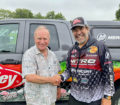by Shane Akin
There are several bodies of water in Iowa that have outstanding crappie fishing. The springtime is the best time to find crappies in the shallows. In Northwest Iowa the lakes that come to mind would be the Iowa Great Lakes Area, Clear Lake along with several smaller lakes and ponds. I spend most of my time on Big Spirit, West Okoboji, Upper Gar and Minnewashta Lake. In most lakes crappies will start to stage in the shallow areas during late ice as the water starts to warm. In Northwest Iowa the ice usually leaves the lake in late March early April. The best places to start looking for these pre-spawn crappies is north bays, or secluded basins that warm faster, canals, any type of back water area, and inlets that have water running into the main lake. To find fish fast and eliminate water, motor around these areas and look for thewarmest water, find the warmer water and you will find the hottest pre-spawn bite!
Until the water temperatures rise above 60 degrees, a 1 degree change can be the difference between catching crappies or not. Crappies start to stage in their pre-spawn mode at 50 to 56 degree temps with spawn starting at 57 degrees. For example, you can have an area a mile long and the majority of the fish will be in an area the size of a house because of a warmer water temperature difference. One of my favorite places to catch crappies is off of old reed beds on Big Spirit Lake or Clear Lake.
Once I have found the warmest water in an area, I will start off using small crank baits and small plastic swim baits to narrow down the school. Equipment for this run and gun approach is a 7’ ultra light rod with 4# power braid. The reason for this is, it allows for long accurate cast to cover ground fast. You are looking for the most active fish with these types of baits. Once the school is narrowed down, I like to slow things down and change things up. I will go to a slip bobber with a plain hook and tip it with a medium sized minnow, I also like to use small hair jigs, tube jigs or tungsten jigs under a bobber tipped with wigglers. The rods I use for this type of fishing are 5 to 6’ ultra lights with 3 and 4lb. test mono. If the fish are really active, you can cast the small crank baits and plastics mentioned above. The baits that I like to use are Rapala ShadRraps, #3 and #5 Original Floating Raps, Kabele’s K-Bait tube jigs, Kenders Outdoor tungsten jigs and various small hair jigs.
Once the spawn starts, you have to really slow down and put the bait right in front of them, this is the time that I only use small jigs under a bobber tipped with wigglers or small plastics. Stay back off the beds and cast up on them and let the jig set there for a couple minutes before you reel in and try the next cast. Black crappies will stay in the shallow areas long after they are done spawning where white crappies will head for their deepwater areas right after spawn. I have seen black crappies stay in these areas for a month or even longer after the spawn. Most crappies will remain in the 15’ range during the summer months once the cooler temps of fall arrive and the temps reach 50 degrees or less they will search out their winter holes. Crappie fishing is a great way to get kids hooked on fishing, so remember to take a kid fishing for the future of the sport.

